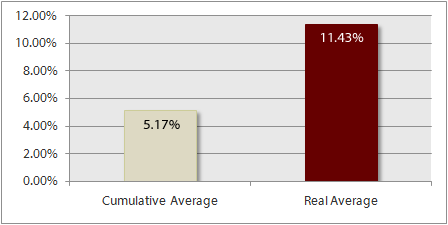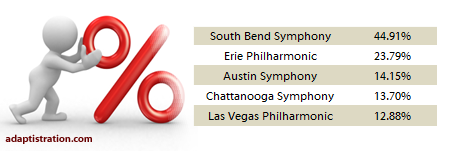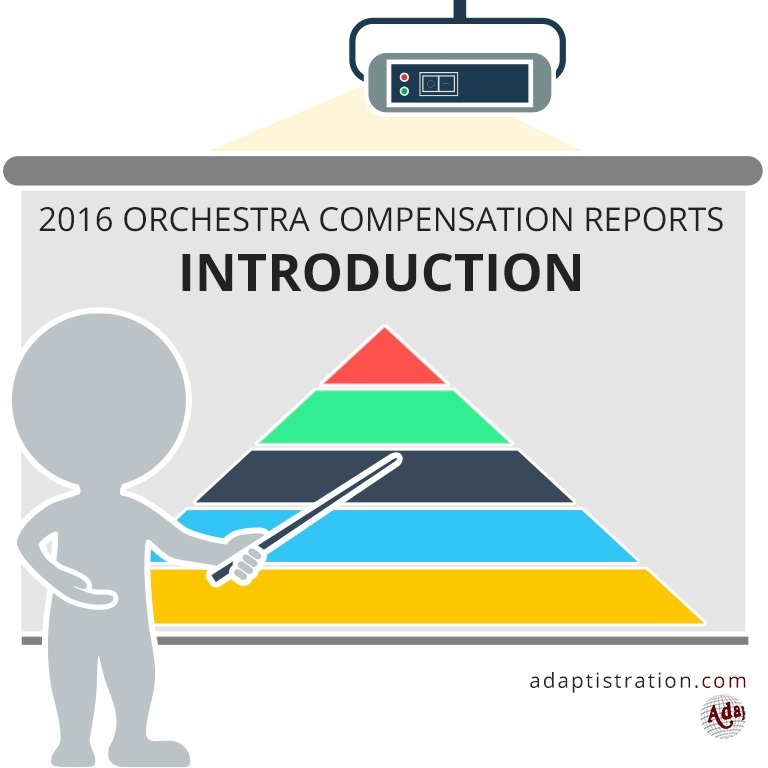If you were the CEO or executive director for a ROPA orchestra in the 2006/07 season, odds are you enjoyed a healthy increase in compensation. In fact, the average executive compensation (for those working a full season) increased at a rate three times greater than the percent increase in total expenditures while base musician compensation decreased by nearly five percent…
WHERE THE DATA COMES FROM
In order to provide information that is as accurate as possible, data from the 2006/07 season is gathered from the following sources:
- Executive compensation figures were obtained from their respective orchestra’s IRS Form 990 for the 2006/07 concert season.
- Total Expenditures were also obtained from each respective orchestra’s IRS Form 990 for the2006/07 concert season.
- Base Musician compensation figures were obtained from records collected by the American Federation of Musicians (AFM) for the 2006/07 concert season.
Adaptistration makes no claim to the accuracy of information from documents compiled or reported by external sources. If you have reason to believe any of the information is inaccurate or has changed since reported in any of the above sources and you can provide documentation to such effect, please feel free to submit a notice.
WHAT THE NUMBERS DON’T SHOW
It is important to remember that the numbers shown do not always convey a complete compensation picture. For example, an orchestra executive may have had a large increase in salary due to a contractually mandatory severance or deferred compensation package when the position was vacated. Additionally, the documents used to gather this data do not indicate how much of the season an individual received a salary. As such, the cumulative compensation may artificially inflate annual earnings. Conversely, reported figures may not reflect bonuses or other incentive payments and may therefore underreport what executives actually earn; therefore, the cumulative compensation for executive directors may or may not be more than what is listed.
As for Regional Orchestra Player Association (ROPA) musicians, unlike the vast majority of their peers in International Conference of Symphony and Opera Musicians (ICSOM) ensembles who all earn no less than the musician base salary, all ROPA ensembles use a tiered system of salary and/or per service payments. For example, although the Richmond Symphony may list a base musician salary of $29,415, more than 60 percent of the musicians earn less than that base salary figure. Those players are paid via sliding per service tier system and may earn as little as a few thousand dollars per season.
In the strictly per service ensembles, the figures listed in the Base Musician compensation column are actually the average annual income earned by section string players (or section wind players if no information for the string players was available). This figure is reported by the AFM because it best represents annual earnings for the musicians who perform the greatest number of services in any per service orchestra; string musicians. However, those compensation figures are not always guaranteed. Additionally, the Base Musician figures do not include any additional payments offered by some organizations such as voluntary outreach services, and minimum overscale payments. Finally, opera or ballet organizations are not included in these reports, only symphonic and chamber orchestra ensembles.
NEW FEATURE: REAL AVERAGES
To date, each year of the Orchestra Compensation Report has provided overall increases and/or decreases in average compensation; however, those figures don’t provide an entirely accurate picture. For example, factoring in compensation data from orchestras that did not pay an executive for an entire season or paid an incoming and outgoing executive in the same season can easily skew that average up or down. As such, this year’s report introduces the average change in compensation from one season to the next using “real averages,” which are based on figures that filter out incomplete compensation records.
When these filters are applied to executive compensation for the 2006/07 season, the data indicates that the average executive serving a full season of employment enjoyed double digit increases in compensation, as illustrated in the chart below.

Due to the nature of work contracts, a real average gap is not applicable. Consequently, from the 2005/06 to 2006/07 season, the average ROPA executive enjoyed a rate of increase in compensation that was 16 times greater than the average orchestra musician. Furthermore, during this same period, the 11.43 percent increase in real average executive compensation was just under three times the average increase in total expenditures among all of the ensembles included in this report.
TOP EARNERS AND QUICK FACTS


- The Toledo Symphony’s executive set a new all time high ROPA executive compensation level at $251,486 which is a 6.85 percent increase over last year’s record setting level.
- The average compensation level for the Top 10 highest paid ROPA executives increased from $151,749 to $161,103 which is a 6.16 percent increase from the previous season.
- The drop in average ROPA base musician compensation is the largest in the past seven seasons and moves that average to a level not seen since the 2003/04 season. Moreover, it lowers the cumulative seven year average to -0.23 percent.
- The number of executives to earn more than $200,000 increased to three.
Practice Makes Perfect Permanent
For all of the inconveniences related to examining compensation data that is two seasons behind, it does provide one valuable benefit. It allows us to compare earlier trends with current realities through the wisdom of hindsight. To this end, the ICSOM executive compensation article from this year’s installment examined two topics that carry equal significance when applied to ROPA executives: the perils of compensating effort over achievement and the importance of transparency as related to verifying the equality of shared responsibility. If you missed those topics, I encourage you to visit them now (scroll to the bottom of the article).
In short, it all comes down to the board and in order to withstand stressors like those many groups are currently enduring, our orchestra stewards will have to reevaluate how they assess executive performance. Ultimately, persistence in these efforts is the key to keeping the business on the right path.




1 thought on “2009 Compensation Report: ROPA Executives”